Icterid
Topic: Biology
 From HandWiki - Reading time: 7 min
From HandWiki - Reading time: 7 min
| Icterids | |
|---|---|
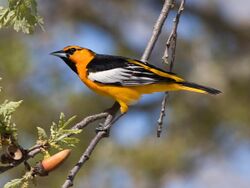
| |
| Adult male Bullock's oriole | |
| Scientific classification | |
| Domain: | Eukaryota |
| Kingdom: | Animalia |
| Phylum: | Chordata |
| Class: | Aves |
| Order: | Passeriformes |
| Superfamily: | Emberizoidea |
| Family: | Icteridae Vigors, 1825 |
| Type genus | |
| Icterus Brisson, 1760
| |
| Genera | |
|
30, See text | |
Icterids (/ˈɪktərɪd/) or New World blackbirds make up a family, the Icteridae (/ɪkˈtɛrɪdi/), of small to medium-sized, often colorful, New World passerine birds. The family contains 108 species and is divided into 30 genera. Most species have black as a predominant plumage color, often enlivened by yellow, orange, or red. The species in the family vary widely in size, shape, behavior, and coloration. The name, meaning "jaundiced ones" (from the prominent yellow feathers of many species) comes from the Ancient Greek ikteros via the Latin ictericus. This group includes the New World blackbirds, New World orioles, the bobolink, meadowlarks, grackles, cowbirds, oropendolas, and caciques.
Despite the similar names, the first groups are only distantly related to the Old World common blackbird (a thrush) or the Old World orioles.
The Icteridae are not to be confused with the Icteriidae, a family created in 2017 and consisting of one species — the yellow-breasted chat (Icteria virens).[1]
Characteristics
Most icterid species live in the tropics, although many species also occur in temperate regions, such as the red-winged blackbird and the long-tailed meadowlark. The highest densities of breeding species are found in Colombia and southern Mexico.[2] They inhabit a range of habitats, including scrub, swamp, forest, and savanna.[3] Temperate species are migratory, with many species that nest in the United States and Canada moving south into Mexico and Central America.
Icterids are variable in size, and often display considerable sexual dimorphism, with brighter coloration and greater size in males being typical. While such dimorphism is widely known in passerines, the sexual dimorphism by size is uniquely extreme in icterids. For example, the male great-tailed grackle is 60% heavier than the female. The smallest icterid species is the orchard oriole, in which the female averages 15 cm in length (6 in) and 18 g (0.040 lb) in weight, while the largest is the Amazonian oropendola, the male of which measures 52 cm (20 in) and weighs about 550 g (1.21 lb). This variation is greater than in any other passerine family (unless the kinglet calyptura belongs with the cotingas, which would then have greater variation[4]). One unusual morphological adaptation shared by the icterids is gaping, where the skull is configured to allow them to open their bills strongly rather than passively, allowing them to force open gaps to obtain otherwise hidden food.
Icterids have adapted to taking a wide range of foods. Oropendolas and caciques use their gaping motion to open the skins of fruit to obtain the soft insides, and have long bills adapted to the process. Others such as cowbirds and the bobolink have shorter, stubbier bills for crushing seeds. The Jamaican blackbird uses its bill to pry amongst tree bark and epiphytes, and has adopted the evolutionary niche filled elsewhere in the Neotropics by woodcreepers. Orioles drink nectar.
The nesting habits of these birds are also variable, including pendulous woven nests in the oropendolas and orioles. Many icterids are colonial, nesting in colonies of up to 100,000 birds. Some cowbird species engage in brood parasitism; females lay their eggs in the nests of other species, in a similar fashion to some cuckoos.[3]
Some species of icterid have become agricultural pests; for example, red-winged blackbirds in the United States are considered the worst vertebrate pests on some crops, such as rice.[5] The cost of controlling blackbirds in California was $30 per acre in 1994. Not all species have been as successful, and a number of species are threatened with extinction. These include insular forms such as the Jamaican blackbird, yellow-shouldered blackbird, and St Lucia oriole, all threatened by habitat loss; and the tricolored blackbird of California, which is threatened by habitat loss and destruction of nests.
Folklore
Cacique and oropendola species are called paucar or similar names in Peru.[6][7] As paucares are considered very intelligent, Native Americans feed the brains to their children to make them fast learners.[8] As the male plays no part in nesting and care of the young, a man who does not work may be called a "male paucar".[9]
Taxonomy
The family group was introduced in 1825 as a subfamily Icterina by Irish zoologist Nicholas Vigors. He placed the subfamily in the starling family Sturnidae.[10]
A phylogenetic analysis of the passerine families by Carl Oliveros and collaborators published in 2019 found that the family Icteridae was sister to the family Icteriidae (containing the yellow breasted chat) and together these two families formed a clade that was sister to the New World warbler family Parulidae.[11]
| |||||||||||||
The genus level cladogram shown below is based on a molecular phylogenetic study by Alexis Powell and collaborators that was published in 2014. The study compared mitochondrial gene sequences.[12] The subfamilies are those that were proposed in 2016 by Van Remsen and collaborators.[13] The numbers of species are taken from the list maintained by Frank Gill, Pamela Rasmussen and David Donsker on behalf of the International Ornithological Committee (IOC).[14]
| Icteridae |
| ||||||||||||||||||||||||||||||||||||||||||||||||||||||||||||||||||||||||||||||||||||||||||||||||||||||||||||||||||||||||||||||||||||||||||||||||||||||||||||||||||||||||||||||
Genera
| Image | Genus | Living Species |
|---|---|---|
 |
Xanthocephalus Bonaparte, 1850 |
|
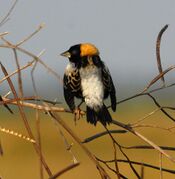 |
Dolichonyx Swainson, 1827 |
|
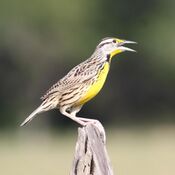 |
Sturnella Vieillot, 1816 |
|
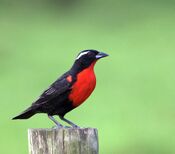 |
Leistes Vigors, 1825 |
|
 |
Amblycercus Cabanis, 1851 |
|
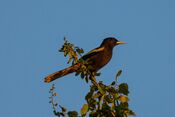 |
Cassiculus Swainson, 1827 |
|
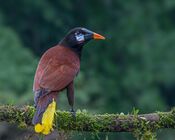 |
Psarocolius Wagler, 1827 |
|
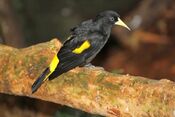 |
Cacicus Lacepede, 1799 |
|
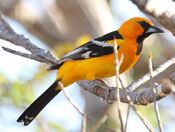 |
Icterus Brisson, 1760 |
|
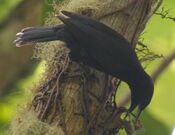 |
Nesopsar P.L. Sclater, 1859 |
|
 |
Agelaius Vieillot, 1816 |
|
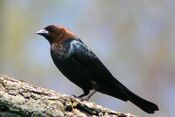 |
Molothrus Swainson, 1832 |
|
 |
Dives Cassin, 1867 |
|
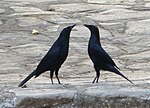
|
Ptiloxena Chapman, 1892 |
|
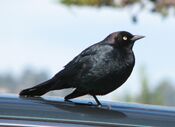 |
Euphagus Cassin, 1867 |
|
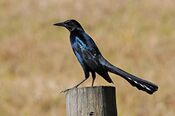 |
Quiscalus Vieillot, 1816 |
|
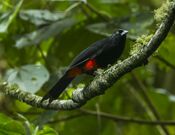 |
Hypopyrrhus Bonaparte, 1850 |
|
| Lampropsar Cabanis, 1847 |
| |
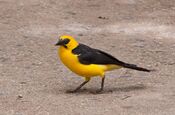 |
Gymnomystax Reichenbach, 1850 |
|
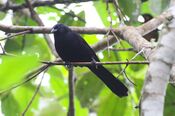 |
Macroagelaius Cassin, 1866 |
|
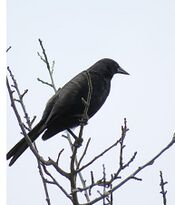 |
Curaeus PL Sclater, 1862 |
|
 |
Amblyramphus Leach, 1814 |
|
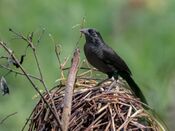 |
Anumara Powell et al., 2014 |
|
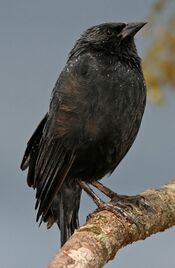 |
Gnorimopsar Richmond, 1908 |
|
| Oreopsar WL Sclater, 1939 |
| |
 |
Agelaioides Cassin, 1866 |
|
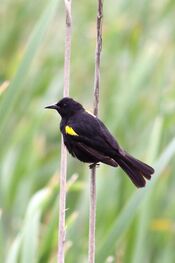 |
Agelasticus Cabanis, 1851 |
|
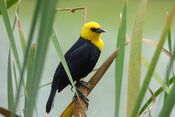 |
Chrysomus Swainson, 1837 |
|
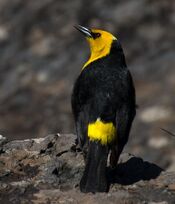 |
Xanthopsar Ridgway, 1901 |
|
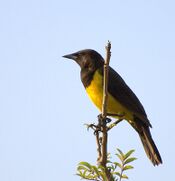 |
Pseudoleistes P.L. Sclater, 1862 |
|
Prehistoric icterid genera that have been described from Pleistocene fossil remains are Pandanaris from Rancho La Brea and Pyelorhamphus from Shelter Cave.
References
- ↑ Chesser, R. Terry; Burns, Kevin J.; Cicero, Carla; Dunn, Jon L.; Kratter, Andrew W.; Lovette, Irby J.; Rasmussen, Pamela C.; Remsen, J. V. et al. (2017). "Fifty-eighth supplement to the American Ornithological Society's Check-list of North American Birds". The Auk 134 (3): 751–773. doi:10.1642/auk-17-72.1. https://zenodo.org/record/1236363/files/article.pdf.
- ↑ Lowther P (1975) "Geographic and Ecological Variation in the Family Icteridae" Wilson Bulletin 87 (4): 481-495
- ↑ 3.0 3.1 Parkes, Kenneth C. (1991), Forshaw, Joseph, ed., Encyclopaedia of Animals: Birds, London: Merehurst Press, pp. 214–215, ISBN 1-85391-186-0
- ↑ Prum, Richard O.; Snow, David W. (2003), "Cotingas", in Christopher Perrins, Firefly Encyclopedia of Birds, Firefly Books, pp. 432–433, ISBN 1-55297-777-3, https://archive.org/details/fireflyencyclope0000unse/page/432
- ↑ Dolbeer, R & S Ickes (1994) "Red-winged Blackbird feeding preferences and response to wild rice treated with Portland cement or plaster" Vertebrate Pest Conference Proceedings collection Proceedings of the Sixteenth Vertebrate Pest Conference (1994) (W.S. Halverson& A.C. Crabb, Eds.) Univ. of Calif.:Davis.
- ↑ Manu Peru Manu - Aves, Enjoy Corporation S. A., 2007, http://www.enjoyperu.com/guiadedestinos/manu/birds/index2.htm, retrieved 2007-09-28
- ↑ Muyuna Amazon Lodge, Iquitos - Peru, http://www.muyuna.com/, retrieved 2007-09-28. Click the link to Fauna and scroll forward one page.
- ↑ Moyobamba - Peru, 2007, http://www.moyobamba.com/online/leyendas_moyobamba.php, retrieved 2007-09-28. The source given is Moyobamba, apuntes turísticos y geográficos by Pedro Vargas Roja.
- ↑ Aves en Soritor - Distrito de soritor Moyobamba - Alto Mayo - San Martín - Peru, 2006, http://www.soritor.com/recursos-naturales/aves-en-soritor/index.html, retrieved 2007-09-28
- ↑ Vigors, Nicholas Aylward (1825). "Sketches in ornithology ; or, observations on the leading affinities of some of the more extensive groups of birds (continued)". Zoological Journal 2 (6): 182-197 [184]. https://www.biodiversitylibrary.org/page/2255443.
- ↑ Oliveros, C.H. (2019). "Earth history and the passerine superradiation". Proceedings of the National Academy of Sciences of the United States 116 (16): 7916–7925. doi:10.1073/pnas.1813206116.
- ↑ Powell, A.F.L.A.; Barker, F.K.; Lanyon, S.M.; Burns, K.J.; Klicka, J.; Lovette, I.J. (2014). "A comprehensive species-level molecular phylogeny of the New World blackbirds (Icteridae)". Molecular Phylogenetics and Evolution 71: 94–112. doi:10.1016/j.ympev.2013.11.009.
- ↑ Remsen, J.V. Jr.; Powell, A.F.L.A.; Schodde, R.; Barker, F.K.; Lanyon, S.M. (2016). "A revised classification of the Icteridae (Aves) based on DNA sequence data". Zootaxa 4093 (2): 285–292. doi:10.11646/zootaxa.4093.2.9.
- ↑ Gill, Frank; Donsker, David; Rasmussen, Pamela, eds (July 2023). "Oropendolas, orioles, blackbirds". IOC World Bird List Version 13.2. International Ornithologists' Union. https://www.worldbirdnames.org/bow/blackbirds/.
External links
| Wikisource has the text of the 1911 Encyclopædia Britannica article Icterus. |
- New World Blackbirds (Icteridae) - videos, photos and sounds at the Internet Bird Collection
- Icteridae - Tree of Life Web Project
Wikidata ☰ Q748159 entry
 |
 KSF
KSF
